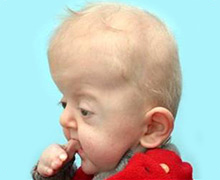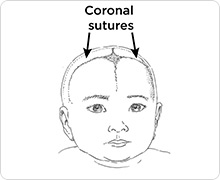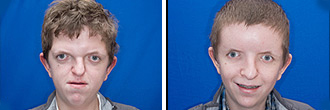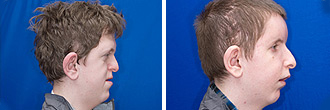Apert Syndrome
What is Apert syndrome?
 Apert syndrome is a rare genetic form of craniosynostosis — the early closing of one or more of the soft, fibrous seams between the skull bones (sutures). It is pronounced Ā-pert.
Apert syndrome is a rare genetic form of craniosynostosis — the early closing of one or more of the soft, fibrous seams between the skull bones (sutures). It is pronounced Ā-pert.
The syndrome affects how your baby’s head, face, hands and feet look and work.
Apert syndrome is rare. It is estimated to occur in 1 in 80,000 to 160,000 newborns.
Children with Apert syndrome have:
- Early closure of both coronal sutures at the top and front of the skull (bicoronal synostosis) with or without early closure of additional sutures (lambdoid and sagittal).This causes an abnormal head shape and limits room for your baby’s brain to grow. It may increase pressure inside their skull.
- Incomplete development of the middle of the face (midface hypoplasia). This will affect how your child looks and how their jaws line up. It can cause problems with chewing and breathing during sleep (obstructive sleep apnea).
- Fingers or toes that are joined together or webbed (complex syndactyly).
Some but not all children with Apert syndrome have delayed development, though this varies from child to child.
Children with Apert syndrome need coordinated care by providers from many areas of healthcare. At Seattle Children’s Craniofacial Center, our team of experts covers 19 different specialties.
What causes Apert syndrome?
Apert syndrome is caused by a change (variant) in a that affects how bones form. The gene is called FGFR2 (fibroblast growth factor receptor 2).
Most often the condition is caused by a new genetic change. (This means it was not inherited from the mother or father.) Other times, a parent passes the FGFR2 gene variant to a child.
The risk of having a child with Apert syndrome is higher if the father is older than 60.
Seattle Children's Craniofacial Center
Symptoms of Apert Syndrome
Apert syndrome will likely affect your baby’s head, face, hands and feet.
Head
Babies with Apert syndrome have a skull that tends to be:
 Drawn by Raymond Sze
Drawn by Raymond Sze
- Tall
- Narrow from front to back
- Wide from side to side
Their forehead is usually flat.
These changes result from the early closure of the coronal sutures — the soft, fibrous seams that go over the top of the head from ear to ear.
Normally, the sutures let the skull get bigger as the brain grows. If a suture closes early, it changes the shape of the head and reduces room for the growing brain. This can increase pressure inside your child’s skull.
Face
Most often, babies with Apert syndrome have the following characteristics:
- The upper part of the face is flat.
- The middle of the face looks sunken in (concave).
- The eyes look big and may stick out.
- When the jaws close, the upper jaw is behind the lower jaw (underbite).
As your child grows, it is likely their teeth will not come together in the front. The undersized upper jaw crowds their teeth, causing dental problems.
Hands and feet
Your baby is likely to have fingers and toes that are webbed. This is because bones in the tips of the index, middle and ring fingers (or toes) are joined together. This is a type of syndactyly.
In more severe cases, the thumb is also fused to the fingers. Your child’s hands and feet may look like mittens or spoons.
Changes affecting other parts of the body
- Many children with Apert syndrome have hearing loss.
- Some children with Apert syndrome may also have a cleft palate (hole in the roof of the mouth).
- Some children with Apert syndrome have problems in the neck (cervical spine). Less often, there may be small differences in the elbow, bones and muscles or internal organs.
Diagnosing Apert Syndrome
To diagnose this condition, your doctor will examine your child’s skull carefully. The shape will help the doctor tell whether any sutures have fused.
Your child’s facial features will help the doctor determine whether they have Apert syndrome or another condition.
Your child may need X-rays of their spine, arms, hands, legs and feet to confirm the diagnosis. A CT (computed tomography) scan can give the doctor more information and help us plan the best treatment for your child.
An accurate diagnosis helps us give your child the best care.
-
Genetic counseling and testing
Our Craniofacial Genetics Clinic helps identify conditions caused by changes in genes. Our geneticists and genetic counselors can advise you about the pros and cons of genetic testing. They explain test results and your chance of having a child with Apert syndrome in a future pregnancy.
A genetic counselor also will give you information about your child’s condition. Counseling can help you make informed decisions about family planning and your child’s treatment.
Our genetic counselors also advise people with Apert syndrome about their chance of having a child with the condition.
A person with Apert syndrome has a 50% chance in each pregnancy of passing down the gene that causes the condition.
Treating Apert Syndrome
There is no single care plan for Apert syndrome. The treatments and timing we recommend depend on how your child is affected by the syndrome.
Our goal is to minimize the number of steps in the treatment plan by improving the outcome of each step. We want your child to have as normal a life as possible, with plenty of time away from the hospital.
-
Easing breathing
Making sure your child is breathing well is an immediate priority. Differences in the bones in the jaw or midface or an abnormal windpipe can make it hard to breathe.
For children with severe breathing difficulties, they may need a tube inserted in their windpipe (tracheostomy) soon after birth.
Later, your child will likely have surgery to reposition their jaw and face bones to help with breathing and other problems.
Sometimes children have trouble breathing while they sleep (obstructive sleep apnea). Over time, this may lead to problems with how the heart and lungs work. It also can contribute to problems with learning and behavior.
We will ask questions during clinic visits to assess whether this may be a problem. To better understand their breathing patterns, we may monitor your child overnight in our sleep lab (PDF) (Arabic) (Simplified Chinese) (Somali) (Spanish) (Vietnamese).
The treatment options and timing will depend on your child.
-
Keeping the brain healthy with room to grow
At about 6 months, some babies with Apert syndrome need surgery to reshape the skull and give the brain more room. The procedure is called a posterior cranial vault distraction.
A craniofacial plastic surgeon and neurosurgeon work as a team in the operating room to protect your child’s brain and achieve the best results. The treatment combines surgery to cut a bone, followed by distraction osteogenesis to grow a longer bone.
Your child’s team will check for signs of fluid buildup (hydrocephalus) and increased pressure in the skull. These problems can happen during infancy or as your child grows.
- If fluid builds up in your child’s brain, they may need a tube inserted to drain away extra fluid. The fluid drains into another part of the body, where it can be absorbed.
- At regular checkups, we ask about warning signs of increased pressure, such as headaches or problems with eyesight. If there are concerns, your child may have imaging scans or a special eye exam to check for swelling at the back of the eye.
-
Protecting the eyes and reshaping the skull
A second operation on the skull brings your child’s eyebrow bone area forward and shortens their high forehead. This allows for continued growth of your child’s brain and helps reshape their skull to look more typical. It also helps protect the eyes.
Our craniofacial plastic surgeon and neurosurgeon work together to perform the fronto-orbital advancement operation.
For a baby with Apert syndrome, we recommend this procedure at 18 months to 2 years. It is done earlier in children with other cranial conditions.
-
Protecting eyesight
An eye doctor (ophthalmologist) will check your child regularly for problems with their eyesight.
- If your child has very shallow eye sockets, their eyes may stick out (proptosis) and be at greater risk of injury.
- Your child’s eyes may not align in the right way because of the position or shape of the eye sockets. This can affect their vision.
- Increased pressure inside the skull can also cause problems with your child’s eyesight.
- Some children with Apert syndrome cannot close their eyes completely. That can irritate the covering on the front of their eyes (corneas). The condition is called keratitis. To avoid harm to their vision, your child may need surgery before they are 2.
-
Surgery to improve breathing and appearance
When your child is 7 to 10 years old, we do an operation to move your child’s midface forward so they can breathe and chew more easily. It improves how their face looks, especially when viewed from the front. The operation also protects their eyes. It is called segmental subcranial distraction.
Our team developed segmental subcranial distraction to treat symptoms and appearance more effectively than the traditional approach (Le Fort III midface advancement). Our Craniofacial Center is the first to use this method. Surgeons around the world are now adopting it.
Segmental subcranial distraction moves bones in the midface different amounts and in different directions. It lengthens the central face and nose and levels the eyes. As a result, the proportions of the face are more normal.
In a study published in the journal of the American Society of Plastic Surgeons, our team showed that this procedure is more effective in normalizing facial proportions than the Le Fort III procedure.


BEFORE (Left): The middle of this boy's face did not grow well because of Apert syndrome. His forehead is high and flat. His cheekbones are sunken. His jaws do not fit together right.
AFTER (Right): As a result of segmental subcranial distraction, the boy's cheekbones have been moved forward. His nose, upper jaw and teeth have moved forward and down. His face is longer and looks more typical. His teeth fit together better.
His upper jaw is finished growing, but his lower jaw will keep growing for several years. At maturity, the jaws will be a good fit.
-
Repairing webbed hands and feet
During their first year of life, your baby will likely need surgery to fix problems with their hands.
If your baby’s thumbs are fused to their index fingers, they must be released at about 6 months. The thumb is critical for the hand to work and develop correctly.
Your child will need multiple procedures to release the fingers on both hands. Ideally, all fingers and thumbs are separated by the time your child is 2 years.
Surgery on the feet is only needed in the most severe cases. Examples would be if the joined toes prevented your child’s foot from striking the ground flat or fitting easily into shoes.
-
Developmental assessment and support
Some children with Apert syndrome have normal cognitive development, but developmental delays are common. The amount of delay varies from child to child.
We will follow your child’s development closely. If we find developmental delays, we will refer you to support services so that your child gets help to reach their full potential.
Your craniofacial pediatrician and social worker will work with you to find resources in the community for children with developmental issues.
-
Dental care and bite alignment
Good mouth care (oral hygiene) is important for all children, but especially those with craniofacial disorders. Our team includes a pediatric dentist and orthodontist who specialize in craniofacial conditions.
The dentist will check your child’s general dental health and look to see if their teeth are too crowded. As your child grows, an orthodontist will check how your child’s upper and lower teeth fit together (occlusion).
Learn more about craniofacial orthodontics.
Your child may need:
- Upper teeth removed to relieve crowding because of their small upper jaw.
- Orthodontic braces to expand the roof of their mouth (palate) and align their teeth.
- Braces or appliances to put their teeth in the best position before jaw surgery.
- Surgery to move the upper jaw forward Le Fort I maxillary advancement if their teeth do not fit together well when your child’s face bones have finished growing. Usually, this happens at 16 years for a female and 18 years for a male.
- Braces to hold the teeth after jaw surgery until they settle in their new position.
Apert Syndrome at Seattle Children’s
Many families have never heard of craniosynostosis before their child is born with Apert syndrome. Each year we care for hundreds of children with craniosynostosis, including rare syndromes like Apert. Our team has more experience caring for children with craniosynostosis than any other center in the United States.
Many of our patients are babies who are newly diagnosed. We also care for children who received their initial treatment at another hospital.
Please call the Craniofacial Center at 206-987-2208 for more information, a second opinion or to make an appointment.
-
Our approach leads to better results with fewer surgeries
Our team is experienced performing the complex surgery your child might need, whether to expand their skull, lengthen their jaw or move bones in their face.
Our approach helps children with Apert syndrome get the maximum benefit from surgeries early in childhood. As a result, later in life, some surgeries are either not needed or are less extensive.
- Seattle Children’s Craniofacial Center is the first to use segmental subcranial distraction to adjust the jaw and middle of the face for children with Apert syndrome. Surgeons around the world are adopting our approach. It allows a child’s face to function more effectively. Our patients like the results.
- Many of our treatments use distraction osteogenesis to stretch a bone so it grows longer. Surgeons cut a bone in the operating room and attach a device called a distractor. The distractor is used for several weeks after a child leaves the hospital. This combination lets us make bigger corrections in bone position.
- 3-D imaging and powerful software help us predict future growth. Our surgery and orthodontic corrections take into account continued growth of your child’s bones. When your child is finished growing, their bones are in the desired position.
-
Our experience improves care for children with Apert syndrome
Every year we care for more than 150 children with craniosynostosis syndromes, including Apert.
Our experience with craniofacial conditions helps us find problems early and take steps to prevent or treat them. We watch carefully for problems that may develop with your child’s breathing, feeding, vision and development.
Our experience with this rare condition helps us continually improve our care. We can recommend the right treatment at the right time to have the best results for your child and your family.
-
Specialists to cover all your child’s needs
Our center has experts in every field your child might need. These 50 specialists work together to diagnose and care for our patients.
Our team meets weekly to discuss children with complex needs and decide on the best care plan for each child. We work together, and with you and your family’s doctor, to manage your child’s personalized care.
A craniofacial pediatrician, nurse and social worker will work closely with your family. They help coordinate care and make sure all your questions are answered.
The pediatrician guides your child’s treatment and decides if other specialists are needed. Your child’s team may include a craniofacial plastic surgeon, pediatric neurosurgeon, oral-maxillofacial surgeon, orthodontist, ophthalmologist and otolaryngologist.
We care for care for your child’s physical, emotional and comfort needs. Read more about the supportive care we offer.
-
We support your whole family
A diagnosis of Apert syndrome can be scary. We take time to explain your child’s condition. We help you fully understand your treatment options and make the choices that are right for your family.
As your child gets older, we make sure they are involved in decisions about their medical care.
Our child life specialists and social workers help your child and your family through the challenges of this condition. We connect you to community resources and support groups.
Seattle Children’s provides craniofacial care for children in an area one-fourth the size of the continental United States. We also care for children from across the globe. This experience has helped us develop systems to provide outstanding, personalized care at great distance.
-
Research to improve care
Our team has created a clinical care pathway for craniosynostosis. It guides our treatment of related syndromes like Apert. This blueprint helps our doctors deliver the best possible care and makes it easier to improve that care. It is based on the research evidence about what is most effective.
We receive more research funding from the National Institutes of Health (NIH) than any other craniofacial center in the United States.
Our research is helping us to:
- Better understand the genetic causes of craniosynostosis and an underdeveloped midface (midface hypoplasia)
- Study how the condition affects learning and behavior
- Build a library of 3-D images to better measure the results of surgery and improve treatments
Learn about craniosynostosis research at Seattle Children’s.
Contact Us
Contact the Craniofacial Center at 206-987-2208 for an appointment, a second opinion or more information.
Providers, see how to refer a patient.

